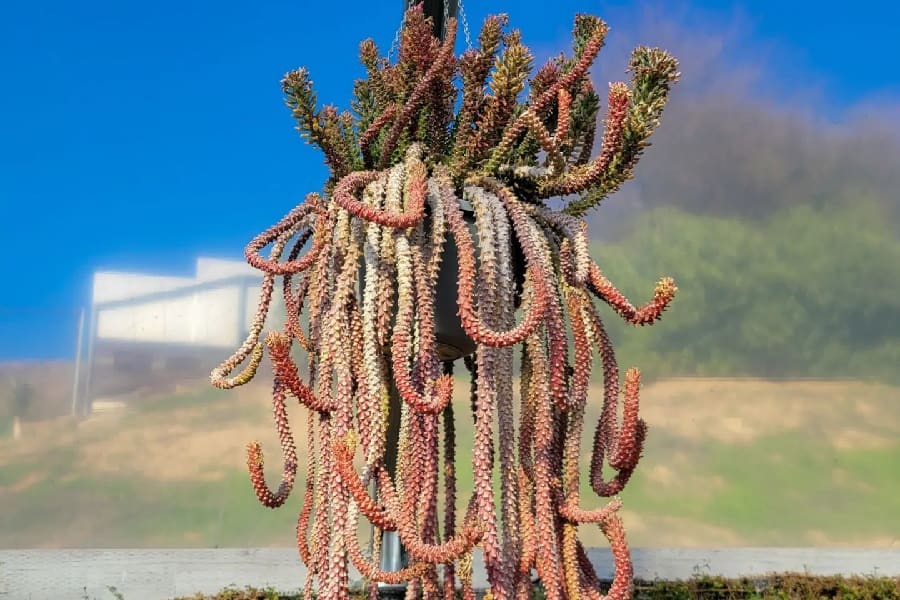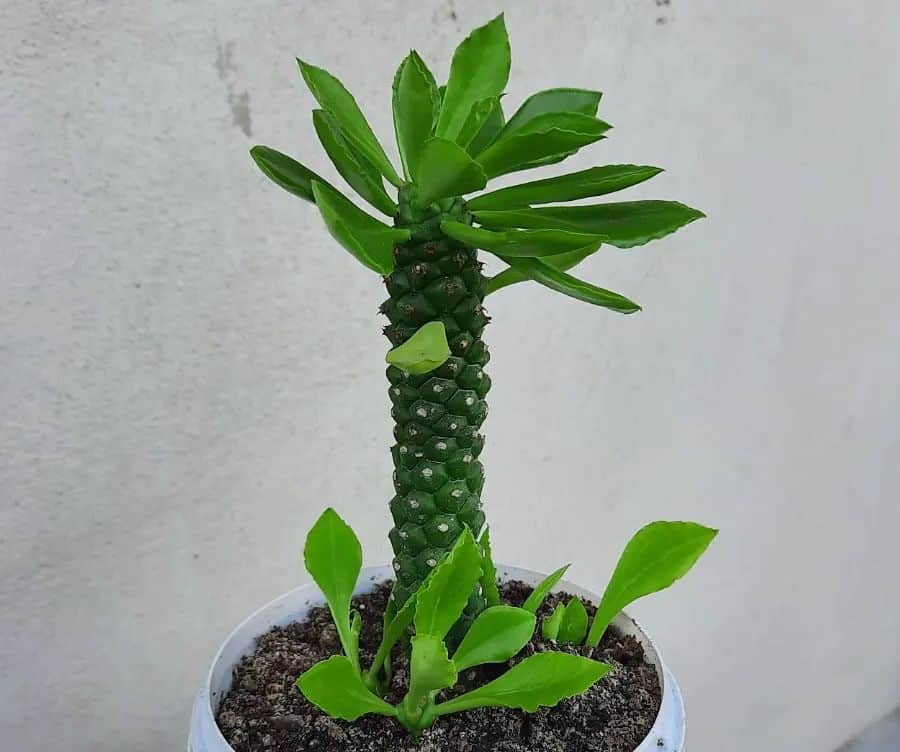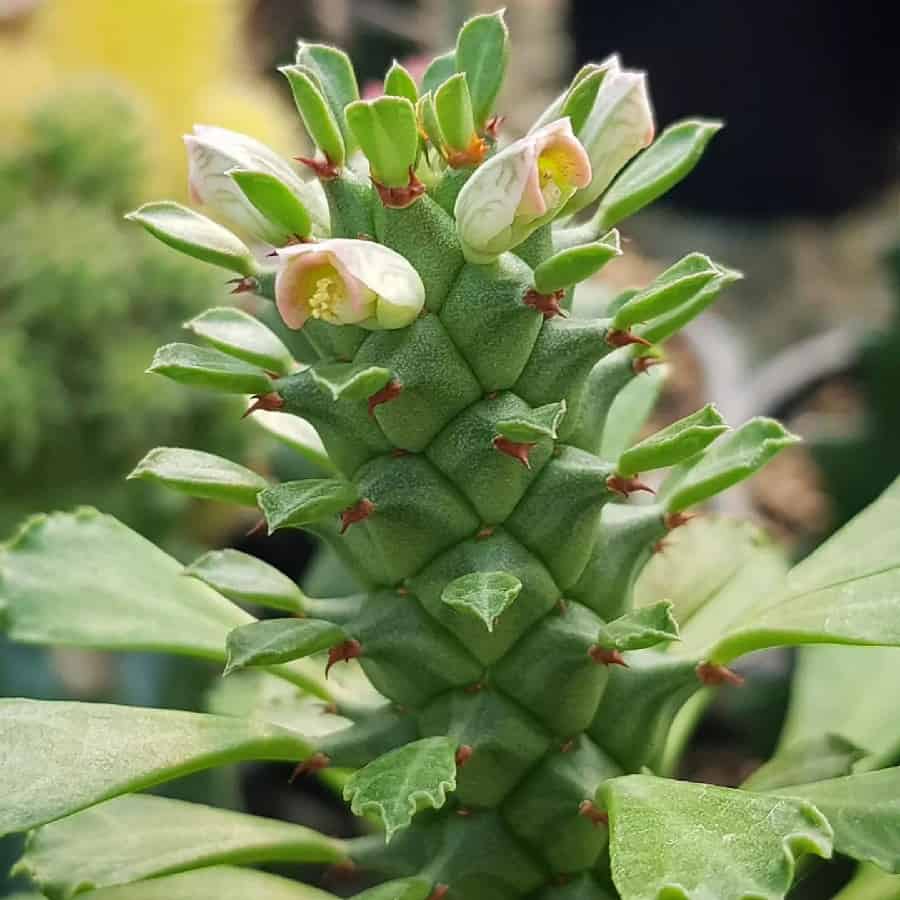Monadenium guentheri: Characteristics and Care
Imagine a succulent that looks like a tangle of sausages or snakes – that’s the unique Monadenium guentheri! With its thick, cylindrical stems and striking mottled flowers, this quirky plant is an eye-catching addition to any home. But don’t let its unusual appearance fool you – with the right care, this low-maintenance beauty will thrive for years. Get ready to become a Monadenium master!

Related Post:
1,000 Types Of Succulents With Pictures
Contents
About Monadenium guentheri
Native to the arid grasslands of southeast Kenya, Monadenium guentheri is a member of the Euphorbiaceae family. These stout plants feature long, cylindrical unbranched stems that can reach up to 5 inches tall and 2-3 inches wide. Each stem is adorned with hexagonal or diamond-shaped patterns, each bearing tiny spines.
In spring and summer, the Sausage Spurge produces small, striking red and greenish-white flowers that resemble tiny cyathia. If pollinated successfully, they’ll even reward you with seed pods! With their unique appearance and low-maintenance nature, these succulents are perfect for beginners.
How to Care for Monadenium guentheri
Light Needs
In their natural habitat, Monadenium guentheri basks in the desert sun. As a houseplant, it craves bright, direct sunlight. A sunny, south-facing window is ideal, but you can also use grow lights to supplement natural light. Just be careful not to expose your Sausage Spurge to too much intense, direct sunlight, or its stems and leaves may develop an unsightly reddish hue.

Watering Wisdom
Hailing from arid regions, Monadenium guentheri is incredibly drought-tolerant. During its active growing season (spring and summer), water it deeply once a week, allowing the soil to dry out completely between waterings. In the winter months (October to March), your Sausage Spurge will go dormant, so you can practically forget about watering it altogether.
Remember, overwatering is the kiss of death for this succulent, so be sure to use a well-draining soil mix and a pot with drainage holes.
Soil Secrets
Your Monadenium guentheri will thrive in a well-draining, sandy soil mix. You can create your own blend with pumice, perlite, peat, or river sand, or opt for a pre-made succulent soil mix. Just make sure it drains quickly to prevent root rot.
Since this succulent produces large, rhizomatous roots, repotting every 2-3 years is recommended to ensure balanced growth.
Fertilizing for Success
While Monadenium guentheri isn’t a heavy feeder, a little extra nutrition can go a long way in promoting healthy growth. During the spring and summer growing season, feed your Sausage Spurge with a diluted liquid fertilizer every 2 weeks. Look for a balanced, water-soluble fertilizer and mix it at half the recommended strength. Avoid fertilizing in the winter when your plant is dormant.

The Perfect Climate
Monadenium guentheri thrives in warm, arid conditions. In the United States, these succulents are well-suited for USDA Hardiness Zones 8b to 10b, where temperatures typically range from 60°F to 85°F (16°C to 29°C). As a native of Africa, your Sausage Spurge won’t tolerate freezing temperatures, so be sure to bring it indoors or into a heated greenhouse during the winter months.
Pest and Disease Prevention
One of the many joys of growing Monadenium guentheri is its resilience against pests and diseases. However, overwatering can quickly lead to root rot, so be vigilant about proper drainage and drying out between waterings. In low-light conditions, you may occasionally encounter scale insects or mealybugs, but these can be easily managed with insecticidal soap or neem oil.
Pruning for Perfect Shape
While Monadenium guentheri doesn’t require frequent pruning, you may want to occasionally trim back any damaged or unsightly stems. Use clean, sharp scissors or pruners and make your cuts just above a leaf node or branching point. This will encourage a fuller, more compact growth habit and maintain your Sausage Spurge’s unique, twisted appearance.
Pruning can also be useful for propagation – simply allow any healthy stem cuttings to callus over before rooting them in fresh succulent soil.
Propagating Monadenium guentheri
One of the best things about Monadenium guentheri is how easy it is to propagate and multiply your collection! Whether you choose to go the stem cutting route or try your hand at growing from seed, propagating this quirky succulent is a breeze.
From Stem Cuttings
- Using clean pruners or scissors, take a 3-4 inch stem cutting from a healthy Monadenium guentheri plant. Make your cut just below a leaf node.
- Allow the cutting to callus over for 2-3 days by placing it on a paper towel in a warm, dry location. This will prevent rot.
- Once calloused, fill a small pot with a well-draining succulent or cactus soil mix.
- Create a hole in the soil and insert the calloused end of the cutting, ensuring at least half is buried.
- Water sparingly and place the pot in a bright, sunny location.
- In a few weeks, you should see new growth emerging, indicating the cutting has successfully rooted!
From Seed
- If your Monadenium guentheri flowers were successfully pollinated, you may notice green seed pods forming.
- Once the pods dry out and split open, collect the seeds inside.
- Fill a seedling tray or small pots with a sterile seed-starting mix.
- Sprinkle the seeds on top of the soil and gently press them down.
- Cover the tray or pots with a clear plastic lid or wrap to maintain humidity.
- Place the seeds in a warm location with bright, indirect light.
- Once sprouted, remove the lid and water sparingly, being careful not to dislodge the delicate seedlings.
- After a few sets of true leaves emerge, you can transplant the baby plants into individual pots.
With a little time and patience, you’ll soon have an abundance of Sausage Spurge plants to share with your fellow succulent enthusiasts. Propagating is not only cost-effective but also incredibly rewarding!
